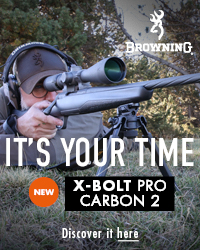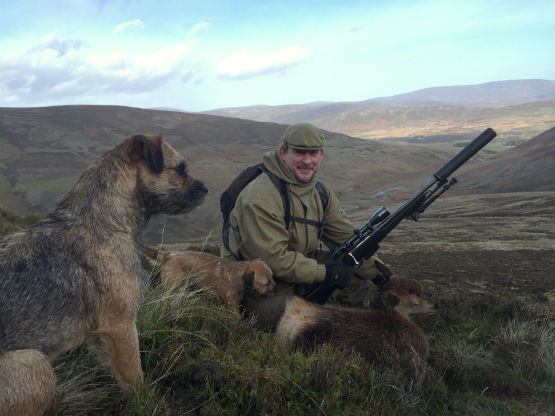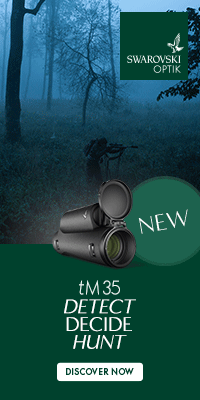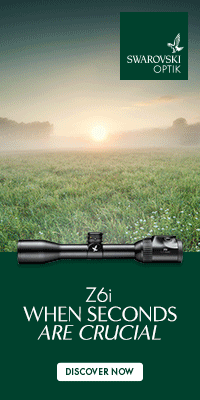David Lloyd Calibres a Cure for Scottish Wind!
- Details
- Monday, 07 December 2015
With various storms battering much of Northern England and Scotland, James Schneider investigates two calibres that may deliver a solution to stalking in high winds.
(Above James Schneider at the Invermark Estate in the Angus Glens)
During a recent outing to Scotland our party was buffeted by the first winds of what was to become Storm Abigail. Several approaches on the hinds were spoiled over the course of the following days as the wind whirled across the hills, burns and glens, shifting speed and direction with no pattern or predictability and moving the deer as a consequence.
Like many in our team, I was stalking with the estate rifle a Tikka .243 with 120g ammunition. Given the wind, the comfort level to which one might extend the distance of a shot was minimal. I was able to make a difficult 220-yard lung shot, that cleanly felled an orphaned calf, but this mercy-cull was only undertaken with the coaching of a highly experienced, accompanying hill stalker, whose guidance was essential to ensuring my elevation and placement were sufficient to account for the conditions. Otherwise, the deer were not allowing us to get anywhere in range for a safe shot and to risk wounding an otherwise healthy animal was unthinkable.
It was late on the second day that we stalked upon a group of hinds via an extreme half-mile belly crawl. Slowly, carefully we slithered forward; through course heather, over a long wet bog, up and down the ebony burn and finally within view of a viable position for the shot. We paused briefly to prepare for the last yards when suddenly a twitch in the front of the herd brought the hinds to attention. Quickly our heads dropped as we flattened ourselves, my left cheek pushing down in to ice-cold, peaty black water, the tip of my nose inches from a still-steaming pile of droppings to my right.
(Below: A distinctive David Lloyd Rifle)
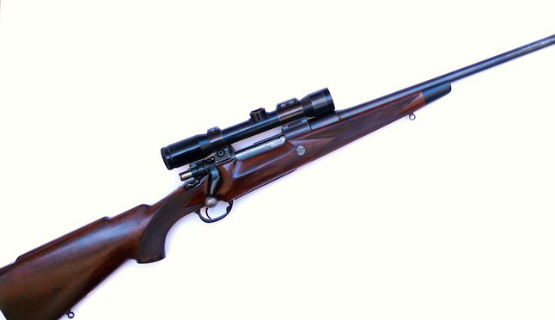
And then from nowhere a sudden swirling change in wind confirmed our presence, scattering the herd up the hill and out of sight. We had been able to reach 250 yards from the beasts, but the high wind drove us to try and close the gap to 200 for a safer shot, sealing our fate.
That evening saw much fireside discussion around the day’s challenges while enjoying several of the more-than 300 single malts to choose from in the Lodge bar. I began to consider a calibre change to allow for flatter and more reliable distance shooting in higher wind conditions.
A follow on visit to the William Evans Gunroom in Mayfair had me chatting with the legendary Freddie Nesbitt and I put this thought to him. A master of his craft, Freddie is a leading expert on calibres and approaches pairing the right calibre to the task at hand with the same finesse as a Sommelier matching the appropriate bottle to the menu.
Freddy’s suggestion was for some lesser known options to consider as true specialist tools for the trade, and I asked him to explain in more detail his reasoning:
“A major problem stalkers face during the hind season is the poor weather conditions, especially heavy winds that seem to come hand-in-hand with hind stalking".
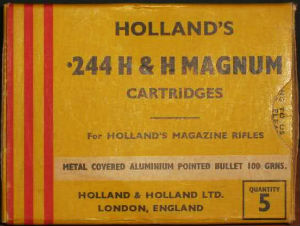 A solution to this was thought up by the great rifle maker David Lloyd with the use of three calibres; the .244 Holland & Holland Magnum (which David Lloyd personally developed), the .264 Winchester Magnum and the .25-06 Remington.
A solution to this was thought up by the great rifle maker David Lloyd with the use of three calibres; the .244 Holland & Holland Magnum (which David Lloyd personally developed), the .264 Winchester Magnum and the .25-06 Remington.
David Lloyd designed and built rifles for use on red deer with his experience coming from shooting in Sutherland, where he had to compete with deep glens and high cross winds. He made his rifles primarily using the three calibers specified above.
The use of these smaller than usual bullet diameters meant he had the speed and flat trajectory required to beat the high cross winds and also the ability to take the longer shot, safe in the knowledge that the bullet would create a clean and effective kill.
By using the Holland & Holland Magnum casing with a .245” or .264” bullet diameter, meant the pressures could be increased to push the bullet heads out to the velocities of 3,500 ft/sec (.244 H&H Mag), and 3,510 ft/sec (.264 Win Mag).
Both of these bullets are at the Scottish legal limit of 100gr and incredibly similar in their energy levels; 2,720 ft:lbs (.244 H&H Mag) and 2,735 ft:lbs (.264 Win Mag).The size of a bullet (i.e. total mass) is what affects the amount of drift, as there is a larger surface area for the wind, and gravity to effect. The sectional density will very much change the overall performance of the bullet and so will the velocity. One point of view is a slow heavy bullet has the greatest chance of hitting the target at point of aim. But this is all dependent on the distance you are shooting.
Since the development of the H&H magnum case, wildcat rounds have been developed and commercialized due to their popularity and strengths in the field. All of these rounds have the ability and strength to cut through high cross winds, with the down side of being loud and having a larger amount of recoil, which in the days of open sights and no sound moderators meant a lot to a stalker (luckily not so much now).
By using this particular casing and the smaller bullet diameters, David Lloyd and Winchester were able to increase the powder charge and subsequently the pressures to create faster and flatter bullets while ensuring to not overpower the charge and thus destabilise the bullets trajectory.
With regard to whether the .244 was preferred over the .264 and vice versa, there is no evidence to say either way. I believe it was a personal preference.
David Lloyd rifles are very much a collector’s item and are becoming quite scarce. The reason being the scope-to-action set up. The calibres are also quite specialist to these rifles, although in recent times due the ease and accessibility for making or buying complete factory ammunition, has allowed for the redevelopment and greater use of these more specialist calibres.
I would like to say that these rounds are brilliant but they aren’t the be all and end all of ammunition as there are a couple of others that will achieve the same as the two spoken of above, for instance the .300 Winchester Magnum and the 7mm Remington Magnum. That being said, the use of smaller diameter heads does keep the meat damage down, which for a professional stalker is paramount, so as ever, it is a matter of personal choice.
What cannot be denied is that the Lloyd Rifle and .244 H&H are exceptional examples of British rifle manufacturing excellence and worthy of acclaim. What is so enthralling is how focused and granular the adaptations are, specifically for highland stalking, and dwindling supply likewise enhances uniqueness and value to the aficionado. I will be looking forward to putting Mr Lloyd’s engineering to the test myself on the hill in due course!
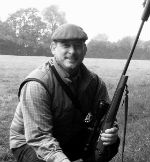 (Left: James Schneider is an experienced deer stalker and member of the Capreolus Club).
(Left: James Schneider is an experienced deer stalker and member of the Capreolus Club).
To read more from James follow this link: young-blood
To learn more about Rifle Calibres follow this link: rifle-calibres where you can also watch a discussion between Freddie Nesbitt and our editor Peter Jones about different calibres suitable for deer.
Finally our thanks go to Freddie Nesbitt of William Evans Gun & Rifle Makers for his contributions to this article.



